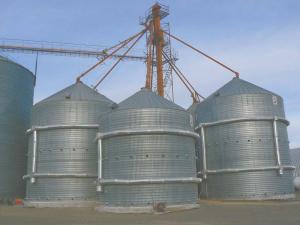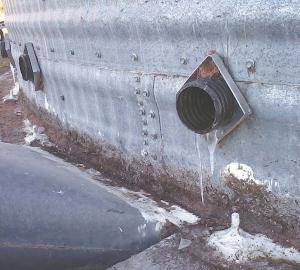2015 - Volume #BFS, Issue #15, Page #44
[ Sample Stories From This Issue | List of All Stories In This Issue | Print this story
]
Air Dry Bin System Dries Corn For Less
 |
 |
“I blow air into the corn through 2 sets of perforated ducts,” explains Casper. “A second set of perforated ducts lets moisture escape out of the bin.”
Casper encircles the outside of the SDS bins with air tubes that deliver a steady flow through perforated tubes crisscrossing the interior. As it passes into the grain, the air picks up moisture and flows into layers of exhaust tubes to exit holes in the bin sides.
“Initially, I only had one exhaust layer with holes at the base of the bin with air also exhausting through the top of the bin, says Casper. “This past year I added an additional exhaust layer in the middle for more flow.”
There are as many as 80 to 85 input and exhaust holes in a 10,000-bu. bin. The number of holes and tubes increases with bin size.
The multiple layers create multiple drying fronts throughout the grain bin. In a 36-ft. deep, 42-ft. dia., 40,000-bu. bin, air will move only 9 ft. from intake to exhaust, compared to 36 ft. in a conventional floor dryer bin. As a result, SDS requires only a fraction of the fan capacity. Casper estimates a 24 hp fan capacity will provide 1 cfm/bu. with the SDS compared to a 180 hp capacity needed to push air through the floor dryer bin.
“I use only two 3 hp axial fans on a 10,000-bu. bin and four 3 hp fans on a 25,000-bu. bin,” explains Casper.
Casper is currently working with an engineer to determine airflow to convert a 55,000-bu. bin. He estimates conversion costs, including electrical work and construction and tube assembly, at about $1.00/bu.
“Other in-bin drying systems are limited to short (20 to 24-ft.) bins, but the SDS system works with any height bin,” says Casper. “Stiffeners are required; however, either interior or exterior stiffeners are acceptable.”
Casper has converted bins on his family’s farm. Over the course of 2 years and many modifications, he dried 150,000 bu. of corn for a friend. He says he learned a lot in the process.
“There is extensive work that needs to be done inside the bin with the network of tubes,” says Casper. “To do it right, you really need my plans and experience.”
While a self-install might be possible using those plans, he advises using a professional contractor. He notes that even with a man lift and appropriate tools, installation on a 25,000-bu. bin can take up to a week and a half.
“I have applied for patents, and I hope to license or sell the design,” says Casper. “In the meantime, I am gearing up to produce parts to order. Let me know exact bin diameters and heights, and we can quote a price and begin the process.”
Contact: FARM SHOW Followup, Moveit, Inc., 171 N. Canal Blvd., Basin City, Wash. 99343 (ph 509 269-4632; bgcasper@hotmail.com; www.moveitinc.com).

Click here to download page story appeared in.
To read the rest of this story, download this issue below or click here to register with your account number.




